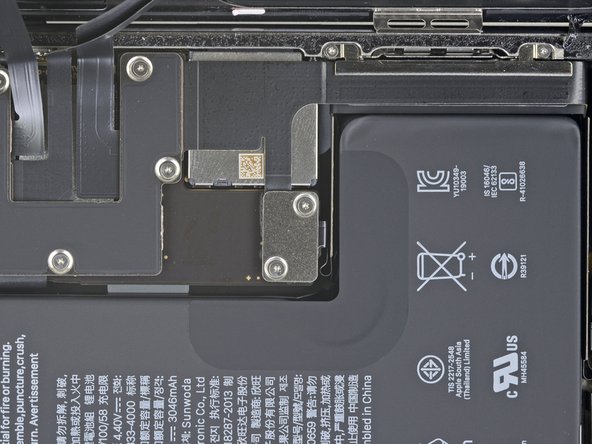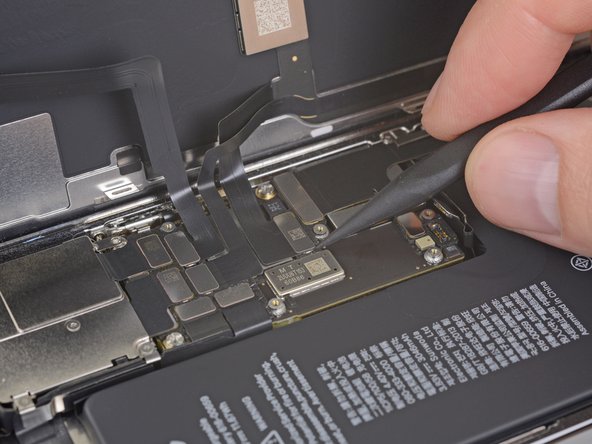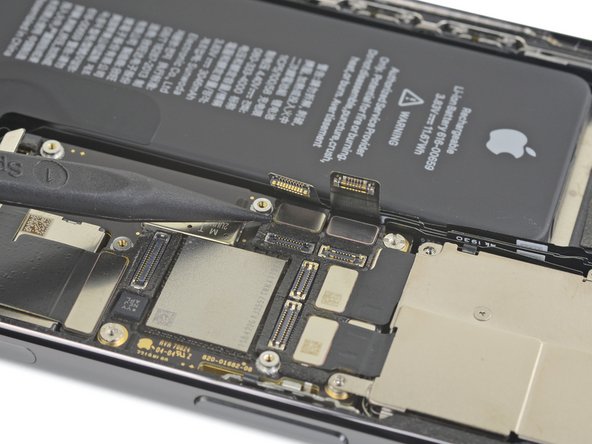iPhone 11 Pro Front-Facing Cameras Replacement
Duration: 45 minutes
Steps: 28 Steps
Heads up: Face ID won't be available after this repair.
Follow this step-by-step guide to remove and replace the front camera assembly (also known as the selfie cam) on your iPhone 11 Pro. Keep in mind, swapping out this part will disable Face ID. While this repair will get your selfie cam back in action, only Apple or an Apple-authorized technician can restore Face ID functionality.
Step 1
Before diving in, make sure your iPhone’s battery is below 25%. Those feisty lithium-ion batteries can be a bit dramatic if they get punctured while fully charged, so let’s keep it safe and sound.
Opening up your iPhone's display may put its waterproof seals at risk. Make sure to have those replacement seals handy before moving on to the next step. If you reassemble your iPhone without replacing the seals, just be extra cautious about avoiding any liquid exposure.
- First things first—let's power off your iPhone. You’ll want it nice and turned off before diving in.
- Next, grab your pentalobe screwdriver and remove the two 6.7 mm-long screws at the bottom of your iPhone. They’re the ones near the edge, just waiting to be unscrewed.
Step 2
Be careful with that opening pick! If you push it in too deep, it might just turn your device into a paperweight. So, let's mark your pick to keep it safe and sound.
Feeling fancy? You can also mark the other corners of your pick with different measurements to keep things interesting!
Or, if you're looking for a creative solution, tape a coin about 3 mm from the tip of your pick. It's a nifty trick!
- Take your opening pick and mark a spot 3 mm from the tip with a permanent marker. Easy peasy!
Step 3
Pop on some safety glasses to keep your eyes safe from any sneaky glass bits that might break free during the repair.
Got a cracked screen on your iPhone? No worries! Just grab some tape and cover that glass to keep any pesky shards contained and avoid any accidental ouches while you tackle the repair.
If you're really in a pinch, a little superglue on the suction cup can help it stick to the screen. Just make sure to be careful!
- Cover the iPhone screen with overlapping strips of clear packing tape, making sure the entire front is shielded.
- If the suction cup refuses to cooperate, fold up a sturdy piece of tape (duct tape works wonders!) into a handle and use that to lift the screen instead.
Step 4
The next three steps show you how to use the Anti-Clamp – our handy little tool designed to make opening your device a breeze. Not using the Anti-Clamp? No worries, just skip ahead three steps for an alternate method.
Want a detailed guide on how to use the Anti-Clamp? Check it out here.
If your iPhone is a little too slick for the Anti-Clamp to grab onto, just stick on some tape to give it a better grip.
- Give that blue handle a good tug backward to set the Anti-Clamp's arms free.
- Slide those arms gracefully over either side of your iPhone—left or right, your choice!
- Place the suction cups at the bottom of the iPhone—one on the front and another on the back.
- Press the cups together to create a strong bond with the surface you're working on!
Step 5
- Slide the blue handle forward to lock those arms in place.
- Give the handle a full 360-degree clockwise spin, or until you see the cups start to stretch out.
- Keep an eye on the suction cups – they should stay nicely lined up. If they start to drift, just loosen them a bit and realign the arms before moving on.
Step 6
Take it easy and only twist a quarter turn at a time—patience is key! Give it a minute between each turn and let the Anti-Clamp and time work their magic for you.
You can also try using a hair dryer, heat gun, or even a hot plate—but be careful, too much heat could mess with the display or the internal battery. So, use with caution and take it slow!
If the Anti-Clamp isn't giving you enough space, just apply a bit more heat to the area and give the handle a quick quarter-turn. It's all about finding that sweet spot.
- Warm up an iOpener and carefully thread it through the arms of the Anti-Clamp.
- Fold the iOpener so it rests along the bottom edge of your iPhone.
- Hold tight for a minute to let the adhesive soften and create a small opening gap.
- Gently slide an opening pick into the gap between the screen and the plastic bezel—avoid prying under the screen itself.
- Go ahead and skip the next three steps.
Tools Used
Step 7
Warming up the bottom edge of your iPhone loosens the stubborn adhesive holding the screen in place, making it a breeze to pop open.
- Grab a hairdryer, heat gun, or an iOpener and warm up the bottom edge of your iPhone for about a minute—just enough to loosen up that stubborn adhesive underneath.
Tools Used
Step 8
- Grab your suction handle and stick it onto the bottom edge of your phone—just steer clear of the curvy part of the glass.
Tools Used
Step 9
The adhesive keeping your display snug is super strong, so you'll need to put in some effort to create that initial gap. If you're struggling to pry it open, no worries! Just apply a bit more heat and gently wiggle the screen up and down to loosen that adhesive. Once you've got a nice gap, you can slide your tool in and keep the repair party going!
- Give that suction cup a strong, steady pull to open up a little space between the front panel and the back case. You've got this!
- Slide an opening pick into the gap you've just created, making sure to avoid poking the screen itself. Go for the plastic bezel instead!
Step 10
Keep your pick to a maximum of 3 mm—going deeper could lead to some unintentional damage to the internal components. Let's keep everything safe and sound!
- Carefully slide the opening pick around the bottom left corner and glide it up along the left side of the iPhone, cutting through the adhesive that's keeping the display snug. Keep it steady and you'll break free in no time!
Step 11
Be aware of the fragile cable hugging the right edge of your iPhone! It's like a shy little secret that doesn't want to be disturbed, so avoid inserting your pick here to keep that cable safe and sound.
Step 12
Keep your pick to a maximum of 3 mm to avoid tangling with those delicate display cables!
- Slide your pick back into the bottom edge of your iPhone and glide it up the right side to keep on separating that adhesive like a pro!
Step 13
The top edge of the display is held in place by a combination of glue and clips. A little teamwork between the two keeps it secure!
- With just a gentle nudge, pull the right edge of the display down a smidge, aiming toward the Lightning port.
- Slide your pick into the top-right corner of the phone like a pro.
Step 14
Keep your pick to a maximum of 3 mm, or you might accidentally tickle the front panel sensor array. Let's avoid any unintentional shenanigans!
- Gently pull the display down towards the Lightning port until you've created a big enough gap for your trusty pick.
- Slide that pick over to the top left corner and slice through any remaining adhesive holding the display in place.
Step 15
- Give that little nub on the suction cup a gentle tug to pop it off the front panel!
Step 16
Hold your horses! Don't go fully separating the display just yet; there are some delicate ribbon cables still happily connected to the iPhone's logic board. Let's keep things intact for now!
- To kick things off, gently swing the display upward from the left side, just like opening a book. Easy peasy!
- Keep your display propped up against something sturdy while you work your magic on the phone. It's like a little break for it!
- When it's time to put everything back together, position the display just right, align those clips at the top edge, and press down gently to snap it into place. If it doesn't click with ease, take a moment to check those clips around the display's edge and make sure they're not bent out of shape.
Step 17
While you're diving into this repair adventure, remember to keep an eye on each screw. They all have their special spots, so be sure to return them to their original homes to keep your iPhone happy and healthy!
- Take out the two 1.3 mm Y000 screws holding down the battery cover bracket.
- When putting it all back together, this is a great moment to power on your iPhone and make sure everything’s working smoothly before sealing the display. Don’t forget to power it completely off again before moving on.
Step 18
- Take off the bracket with a confident flick.
Step 19
Take it easy around the black silicone seal by this and other board connections. That little barrier is guarding your device from water and dust sneaking in.
- Grab a spudger or a clean fingernail and gently lift that battery connector up from its cozy spot on the logic board. It's like giving it a little nudge to say, 'Hey, time to come out!'
- Now, bend the connector ever so slightly away from the logic board. This little move is to make sure it doesn’t accidentally make friends with its socket again and power up your phone during the repair. We want to keep it all nice and safe while you work!
Tools Used
Step 20
- Grab your trusty Y000 driver and let’s get to work! You’ll want to unscrew six tiny 1.3 mm screws that are holding the logic board cover bracket in place. It’s like a mini treasure hunt, but instead of gold, you’re uncovering the heart of your device!
Step 21
- Take off the bracket carefully.
Step 22
- Gently use a spudger or even your fingernail to unplug the OLED panel cable connector. Easy does it!
- When reconnecting these press-fit connectors, line it up carefully and press down on one side until you hear a click, then do the same on the other side. Avoid pressing in the middle—misalignment can bend the pins and cause permanent trouble.
Tools Used
Step 23
- Grab your trusty spudger or use your fingernail to pop off the front sensor assembly cable connector. Nice and easy.
- Do the same with the digitizer cable connector—spudger or fingernail, whichever feels right, just disconnect it.
- If your screen acts like it’s ignoring your touch after reassembly, unplug the battery and give that connector another solid click. Make sure it’s clean and seated perfectly—no dust bunnies allowed.
Tools Used
Step 24
- Time to say goodbye to that display assembly! Carefully remove it to continue your repair journey.
- Before you seal everything back up, think about adding some waterproof adhesive around the edges of the display. If you're up for it, take a little break here to get that done!
Step 25
- Gently pry open the connection of the Face ID dot projector and sensor cables from their spots on the logic board using a spudger or your trusty fingernail. You've got this!
Tools Used
Step 26
- Carefully nudge the Face ID cable connectors out of the way so you can reach the selfie cam connector chilling underneath.
- Pop off the selfie cam by gently prying its connector straight up—give it a little lift!
Step 27
Hold on to the front camera assembly with tweezers, and watch out for those sneaky fingerprints on the sensors!
- Gently slide the front camera assembly down and to the left a bit to pop it free from its snug home in the enclosure.
Tools Used
Step 28
- Take a moment to compare your shiny new replacement part with the original—you might need to swap over some little bits or peel off those sticky backings before getting started with the installation.
- Putting your device back together? Just retrace your steps—we're all about going backward to move forward!
- Don't forget to give your old tech the right send-off by taking it to an R2 or e-Stewards certified recycler.
- Things didn't quite go as planned? No worries! Give some basic troubleshooting a shot, or reach out to the Salvation Repair community for some extra brainpower.









































































